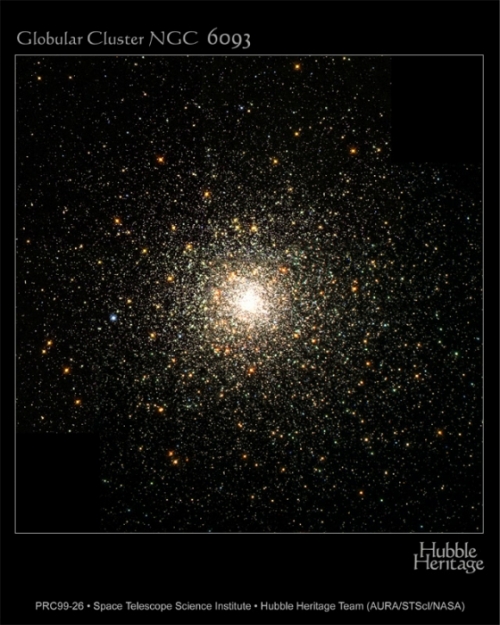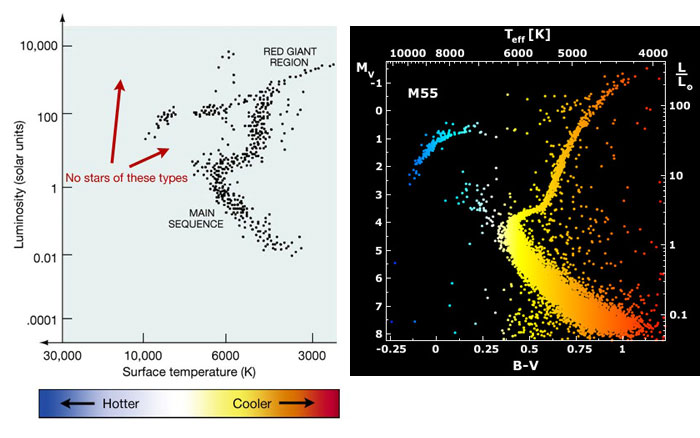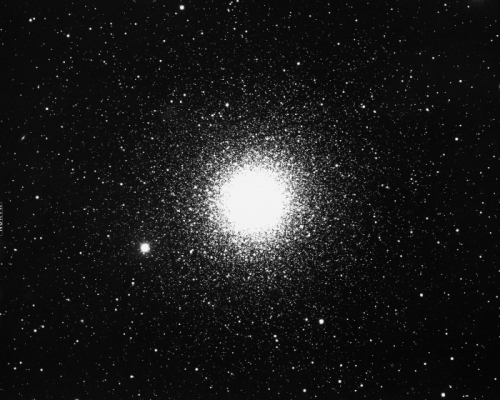Blue Stars in Old Global Clusters Blue Stars in Old Globular Clusters
Globular Clusters
![]() Print
Print

Figure 7.7: Hubble Space Telescope image of the Globular Cluster M80 showing how common reddish stars are in the cluster, as well as a lack of any obvious blue stars.
Globular clusters are very massive objects that contain hundreds of thousands or perhaps a million stars. The HR diagram for a typical globular cluster looks very different than that of an open cluster. There are no Main Sequence stars of types OBAF, but there are many red giants. The brightest stars in a globular cluster are those at the tip of the red giant branch in the HR diagram, which explains the red appearance of the bright stars in color images of the clusters, like the one above. You can also see stars populating the horizontal branch (and also why it is called the horizontal branch), the asymptotic giant branch, and even some stars that have colors and magnitudes of F stars, but far fewer than the G stars just below and to the right of them on the Main Sequence.
Below is a schematic diagram of the HR diagram of a typical globular cluster. I have also included the real HR diagram of M55 for comparison.

Figure 7.8: LEFT: Schematic HR diagram of a globular cluster. RIGHT: Color Magnitude (HR) Diagram of M55 from real data
Comparison of two HR diagrams of a typical globular cluster, noting that there are no Main Sequence stars of types O, B, or A, a densely populated lower Main Sequence and red giant branch, and a relatively large population of white dwarf stars.
The density of stars inside a globular cluster is significantly higher than the density of stars around the Sun. We have measured the distance to the nearest star to the Sun, Proxima Centauri, and it is 4.2 light-years, or about 1.3 parsecs. Thus, if we were able to draw a sphere around the Sun with a radius of 1.3 parsecs, it would only contain 2 stars: the Sun and Proxima Centauri. If you were to draw this same sphere in the center of the globular cluster M13, it would contain approximately 10,000 stars. As part of a research study in 1996 of the globular cluster M15, astronomers using the Hubble Space Telescope observed about 30,000 stars within 6.7 pc of the core of this globular cluster. Thus, if the Sun were inside a globular cluster, we would see many thousands of stars in the sky many times brighter than the brightest stars we see in our night sky.
Globular clusters are not found to contain any gas, nor are they, in general, associated with reflection or emission nebulae, like we see with open clusters. Also, unlike open clusters, we find globular clusters in every direction on the sky. They do not seem to have any particular association with the band of light that we call the Milky Way. There are several globular clusters visible near the Milky Way in the part of the sky you studied using the Starry Night file on the last page; however, there are many more distributed all over the sky.
When we observe the stars in globular clusters spectroscopically, we can also measure the abundance of chemical elements in their atmospheres. Again, this observation reveals another difference between these star clusters and open clusters. On average, the abundance of all elements heavier than helium is only 1-10% of the abundance of these same elements in the Sun and in the stars in open clusters.
Watch out for this misconception!
When you look at images of globular clusters like the one above, or at an even more extreme case like the one below, you are probably tempted to think that the stars in the core must be very close to each other, and perhaps even collide regularly.

Figure 7.9: Image of globular cluster M15 from the Kitt Peak 4 meter, showing how densely packed the inner core appears in this type of image. The core of the cluster looks to be very densely populated by stars.
We can actually do a quick calculation to prove to ourselves the answer to the question: How full is a globular cluster?
Assume all stars in the cluster are the size of the Sun, or roughly 700,000 km in radius. Assume the radius of a typical globular cluster is 10 parsecs, or .
The volume of one Sun-like star is: .
If a typical globular cluster has 500,000 stars in it, those stars fill a volume of .
The volume of the entire cluster is .
So, the stars in the cluster only fill of the cluster's total volume. That means that, even though these clusters are incredibly dense compared to typical interstellar space, the stars are still separated by many AU and are unlikely to ever experience direct collisions. Even inside the innermost core of the cluster where the density is higher, it is still not high enough for the stars to be packed very tightly together.
If you would like to see an animation that shows the motions of the stars in a typical cluster, please see the IAS website.
Source: https://www.e-education.psu.edu/astro801/content/l7_p5.html